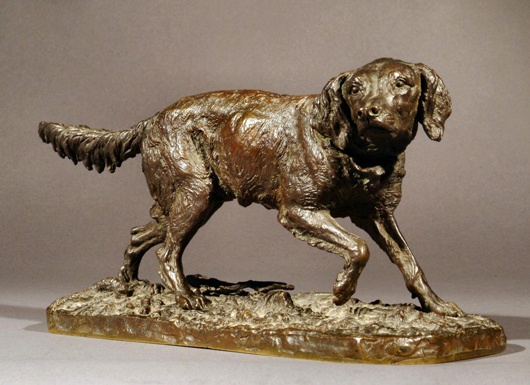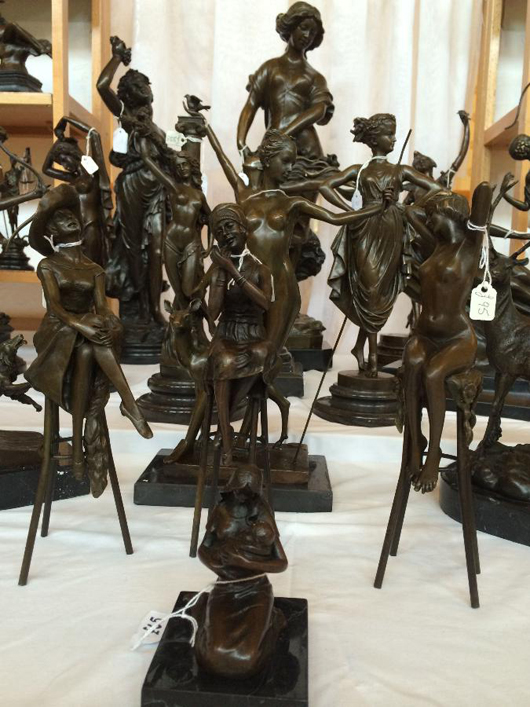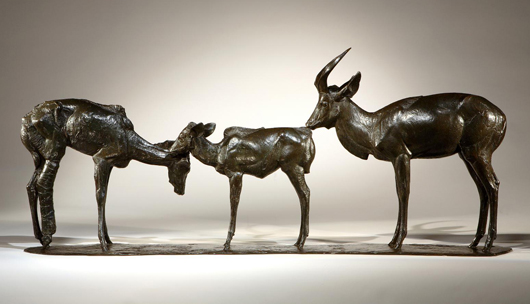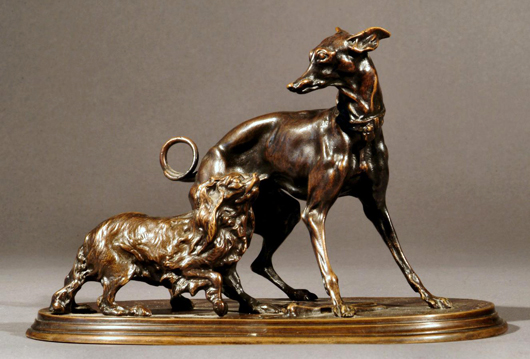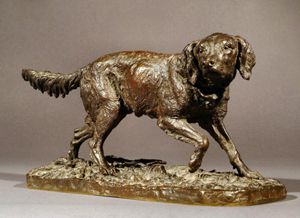
LONDON – Bit of a dilemma this week. I thought I’d write about collecting bronzes … so we visited one of our local antiques fairs but failed to find a single one. And then we came across the large grouping pictured below. There’s not an antique among them, although at the outset, let me make it clear the dealer selling them went to great pains to point out the fact that they are modern reproductions.
Each piece was made, using the traditional lost wax method, from real bronze and not poured resin, and each stands on a real marble base. The bronzes are imported from their manufacturers in Europe, not China, and retail for between £100-£300. In a hundred years’ time they will be antiques, but a cursory glance is enough to show they might have been made yesterday. All together in a big group like this, it’s easy to see their rawness and lack of patination, which is the sheen brought on by age. Put one at the back of a dusty junk shop or poorly lit saleroom and the single figure might fool the unwary.
So, let’s be careful out there. Learn about bronze figure groups, how they were made and by whom, and short of buying only from those sources where purchases are guaranteed, you stand a better chance of not being “taken.”
First, let’s go over the lost wax production method. Cire-perdue, to use the French name by which some collectors know it, has been used since ancient times, because it achieves greater definition than straightforward mold-casting methods. Rembrandt Bugatti (1884-1916), brother of the great car maker, Ettore, was an internationally known bronze sculptor of animals, an “animalier,” as they were called, and one of many fans of the process.
In 1903, he moved to work in Paris, where he met and consequently signed an exclusive contract with one of the greatest bronze founders of the time, Adrien-Aurélien Hébrard. The deal was that Rembrandt’s work should be cast in only small limited and numbered editions, while the very best pieces would be cast as unique one-offs.
His inspiration was the animals he saw in zoological gardens, where he found an almost endless supply of subject matter, notably his favorite, the Jardin des Plantes in the city where he modeled wolves, lions, panthers and deer.
He would spend hours and sometimes days on end in all types of weather watching the creatures and their movements. He took no notes, but working with Plasticine (a putty-like modelling clay similar to Play-Doh). He would suddenly dash off a bold model quickly but with great accuracy, destroying anything he was not immediately satisfied with. Back in the studio and using the Plasticine as a working “study,” Rembrandt then executed his more detailed models to send to the foundry to be cast in bronze.
There a mold was taken and coated on the inside with wax to produce an exact replica of the finished bronze. In simple terms, this is coated with ceramic slurry and silica sand to produce a shell around the wax. When the shell is heated, the wax melts and is “lost,” through drain holes, leaving a void to be filled with the molten bronze. When cool, the shell is broken away, leaving an exact replica in metal. However, modern lost-wax processes use flexible rubber, which can be easily removed and reused.
The golden period of the French Animalier School was between 1830 and 1890, and the creatures chosen to be immortalized ranged from the humble to the mighty. The hunter might commission a model of his favourite gun dog with its quarry, while the racehorse owner might celebrate a victory with a study of the victor. When not working to specific commissions, sculptors produced export items from the entire animal kingdom, much of it finding its way to Britain.
Arguably the first and perhaps most highly regarded member of the school was Antoine Louis Barye (1796-1875). He was born in Paris and worked almost exclusively on studies of wild animals, his masterpieces including Tiger devouring a Gavial (crocodilian) of the Ganges, now in the Louvre; and Lion and Serpent, for the Gardens of the Tuileries royal residence. Many royal commissions followed, but because of an obsession with perfection, Barye was not financially successful. He was declared bankrupt in 1848 and his molds and models sold to pay his debts. Undaunted, Barye continued to work and was appointed Professor of Drawings at the Museum of Natural History at the Jardin de Plantes in 1854, a post he held until his death.
By 1857, he was rid of his debts and began casting works again to great acclaim. He was awarded the Grand Medal at the Exposition Universelle in Paris in 1867 and was named the first President of the Central Union of Beaux Arts. Today, most of Barye’s plasters and models are the property of the Louvre, while his bronzes are the preserve of the wealthiest collectors.
A more accessible member of the Animalier School is Pierre Jules Mêne (1810-1877) a contemporary of Barye whose bronze groups are still regularly found in fine art auctions. They can be picked up at prices starting at £600-£1,000. Mêne was born in Paris, the son of a metal worker who was no doubt responsible for much of his son’s technical grounding in the art of bronze casting. But as a sculptor, Mêne was largely self taught. His career was studded with honors and accolades. By 1838, he had opened his own foundry, and in the same year he exhibited for the first time at the Paris Salon. He went on to win a number of medals there, culminating in him being awarded the Legion d’Honeur in 1861.
Mêne’s work was greeted in Britain with as much enthusiasm as in his native France, and he exhibited at the Great Exhibitions of 1851 and 1862. Among a number of bronzes made specifically for the British market was his Derby Winner, which he exhibited at the Salon in 1863. Such was Mêne’s success in Britain that the Coalbrookdale Company made copies of his work, signing them “Coalbrookdale Bronze,” while Staffordshire potters such as Copeland’s cast copies in unglazed, white porcelain intended to resemble marble and known as Parian.
If you care at all for bronze, don’t ever polish it. Bronze is highly susceptible to corrosion – it turns dark brown or greenish brown when exposed to the atmosphere — but this is considered one of the metal’s wonderful attributes. The surface color – or patina, as it is called – should be protected at all costs. To do otherwise could have a seriously adverse affect on the value of a bronze object and spoil its appeal for years to come.
So, under no circumstances should any metal polish be used on a bronze, and it’s also best kept away from water. Instead, a light dusting is all that is required and perhaps careful rubbing with a clean cloth. Avoid rubbing hard, particularly on raised parts where the patina could be worn away. Dust in crevices can be removed with a cotton-tipped swab (Q-Tip) moistened with saliva. Dull patination can be revived with the sparing application of a microcrystalline wax.
# # #

ADDITIONAL IMAGES OF NOTE
